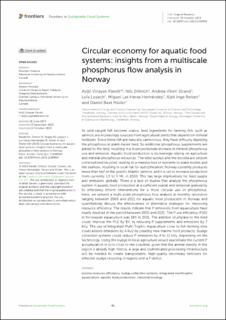| dc.contributor.author | Pandit, Avijit Vinayak | |
| dc.contributor.author | Dittrich, Nils Maximilian | |
| dc.contributor.author | Strand, Andrea Viken | |
| dc.contributor.author | Lozach, Loïs | |
| dc.contributor.author | Las Heras Hernandez, Miguel | |
| dc.contributor.author | Reitan, Kjell Inge | |
| dc.contributor.author | Mueller, Daniel Beat | |
| dc.date.accessioned | 2024-02-01T08:11:13Z | |
| dc.date.available | 2024-02-01T08:11:13Z | |
| dc.date.created | 2023-10-26T15:28:44Z | |
| dc.date.issued | 2023 | |
| dc.identifier.citation | Frontiers in Sustainable Food Systems. 2023, | en_US |
| dc.identifier.issn | 2571-581X | |
| dc.identifier.uri | https://hdl.handle.net/11250/3114966 | |
| dc.description.abstract | As wild-caught fish become scarce, feed ingredients for farming fish, such as salmon, are increasingly sourced from agricultural plants that depend on mineral fertilizers. Since these fish are naturally carnivorous, they have difficulty digesting the phosphorus in plant-based feed. So additional phosphorus supplements are added to the feed, resulting in a disproportionate increase in mineral phosphorus use and emission. Aquatic food production is increasingly relying on agriculture and mineral phosphorus resources. The feed surplus and the excreta are seldom collected and recycled, leading to a massive loss of nutrients to water bodies and the seafloor, resulting in local risk for eutrophication. Norway currently produces more than half of the world’s Atlantic salmon, and it is set to increase production from currently 1.5 to 5 Mt. in 2050. This has large implications for feed supply and emissions globally. There is a lack of studies that analyze the phosphorus system in aquatic food production at a sufficient spatial and temporal granularity to effectively inform interventions for a more circular use of phosphorus. Here, we present a multi-scale phosphorus flow analysis at monthly resolution ranging between 2005 and 2021 for aquatic food production in Norway and quantitatively discuss the effectiveness of alternative strategies for improving resource efficiency. The results indicate that P emissions from aquaculture have nearly doubled in the period between 2005 and 2021. The P use efficiency (PUE) in Norwegian aquaculture was 19% in 2021. The addition of phytase to the feed could improve the PUE by 8% by reducing P supplements and emissions by 7 kt/y. The use of Integrated Multi-Trophic Aquaculture close to fish farming sites could absorb emissions by 4 kt/y by creating new marine food products. Sludge collection systems could reduce P emissions by 4 to 11 kt/y, depending on the technology. Using the sludge in local agriculture would exacerbate the current P accumulation in soils close to the coastline, given that the animal density in this region is already high. Hence, a large and sophisticated processing infrastructure will be needed to create transportable, high-quality secondary fertilizers for effective sludge recycling in regions with a P deficit. | en_US |
| dc.language.iso | eng | en_US |
| dc.rights | Navngivelse 4.0 Internasjonal | * |
| dc.rights.uri | http://creativecommons.org/licenses/by/4.0/deed.no | * |
| dc.title | Circular economy for aquatic food systems: insights from a multiscale phosphorus flow analysis in Norway | en_US |
| dc.type | Peer reviewed | en_US |
| dc.type | Journal article | en_US |
| dc.description.version | publishedVersion | en_US |
| dc.rights.holder | © 2023 Pandit, Dittrich, Strand, Lozach, Las Heras Hernández, Reitan and Müller. | en_US |
| dc.source.volume | 7 | en_US |
| dc.source.journal | Frontiers in Sustainable Food Systems | en_US |
| dc.identifier.doi | 10.3389/fsufs.2023.1248984 | |
| dc.identifier.cristin | 2188918 | |
| dc.relation.project | Norges forskningsråd: 268338 | en_US |
| dc.relation.project | Norges forskningsråd: 324613 | en_US |
| dc.source.articlenumber | 1248984 | en_US |
| cristin.ispublished | true | |
| cristin.fulltext | original | |
| cristin.qualitycode | 1 | |

